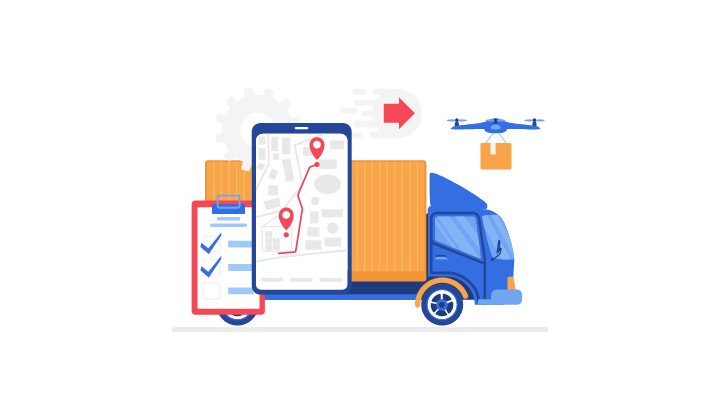In today’s fast-paced logistics environment, the ability to optimize delivery route planning is more crucial than ever. As an expert in logistics, I’m here to share seven actionable tips that will not only streamline your delivery processes but also significantly reduce logistics costs. Let’s dive in and transform your delivery route planning for the better!
Amazing Optimizing Route Planning Statistics That’ll Amaze You
- The logistics and transportation sectors hold the biggest part of the route optimization market.
- Asia-Pacific is expected to grow the fastest in this market because of the increasing demand from e-commerce and emerging online transport companies.
- A Geotab survey reveals that 63% of fleet managers who use telematics technology see route optimization as their main focus, showing its importance in logistics.
- A survey by Bobit Business Media for Verizon Connect found that 72% of government fleets use GPS tracking. Also, 75% of these fleets find the technology very useful.
- Despite significant tech progress, 28% of fleets don’t have fleet maintenance software.
- A study by Dot Distribution notes that delivery times influence 87% of online shoppers’ buying choices.
What is Route Optimisation?
Route optimisation is a technology used by delivery companies to improve delivery routes by generating more efficient routes. In other words, it is the method used to determine the most cost-effective and time-efficient route from point A to point B.
Route optimisation is critical for company success since it helps organisations to not only execute orders but also successfully combine aspects like as
- Drivers’ schedules
- Available hours:
- Total stops
- Estimated fulfilment rates
- Regulatory requirements
It is crucial to note that route optimisation is not about finding the quickest or cheapest path. Instead, the goal is to discover the most efficient and appropriate path for all variables involved.
For example, simple route optimisation will plan for the lowest possible cost to meet client orders while ensuring that all orders are fulfilled, regardless of price.
Complex route optimisation adopts a more balanced technique, which can be tailored to the company’s customer service and financial goals. This could include meeting client delivery needs while saving money or delivering things that generate the most profit when delivery resources are restricted.
Why Effective Delivery Route Planning is Important?
As we approach 2027, the global last-mile delivery market is projected to soar beyond $200 billion, a significant leap from $108.1 billion in 2020. This explosive growth underscores the critical importance of effective delivery route planning. As the demand for faster, more reliable deliveries escalates, optimizing routes not only becomes essential for meeting customer expectations but also for sustaining profitability and competitiveness in this rapidly expanding sector.
Efficient delivery route planning enables companies to maximize resource utilization, minimize delivery times, and reduce operational costs, making it a cornerstone of success in the logistics industry.
Read Once! Benefits of Integrated IT Systems to Logistics Companies
10 Strategies to Optimize Your Delivery Route Planning in 2024
In 2024, mastering delivery route planning is essential for maximizing efficiency and reducing costs in logistics. According to research, route optimization can significantly lower fuel costs by 20%. In this guide, we’ve compiled 10 innovative strategies to optimize your delivery routes, ensuring faster and more cost-effective deliveries. Discover how these techniques can transform your logistics operations and keep you ahead in the competitive market.
1. Use Advanced Mapping Technology
First and foremost, harness the power of advanced mapping technologies. These tools are designed to provide real-time traffic updates, road conditions, and the most efficient pathways. By integrating these technologies into your logistics management software, you ensure that your drivers always take the quickest and safest routes.
2. Utilize Predictive Analytics
Predictive analytics can revolutionize how you anticipate future conditions on the roads. By analyzing historical data and trends, this technology predicts traffic patterns, helping you to avoid potential delays before they happen. Implementing predictive analytics into your strategy ensures that you’re always a step ahead.
3. Regularly Update Route Plans
The world of logistics is ever-changing, and so should your route plans. Regular updates are necessary to accommodate new road constructions, changes in traffic flow, or updated delivery locations. Make it a habit to review and adjust routes periodically to maintain optimal efficiency.
4. Optimize Load Management
Efficient load management is key to optimizing delivery route planning. Organize the delivery schedules and vehicle loads in a way that minimizes empty miles and maximizes delivery capacity. This strategic approach not only speeds up the delivery process but also reduces fuel consumption and wear on vehicles.
5. Foster Driver Communication
Enhance the communication channels between dispatchers and drivers. Real-time communication helps to address any on-the-road changes swiftly and efficiently. This ongoing interaction ensures that any adjustments to routes or schedules are communicated immediately, keeping your operations smooth and responsive.
6. Invest in Training
Investing in comprehensive driver training programs is crucial. Well-trained drivers are more efficient, safer, and capable of making real-time decisions that align with optimized route planning. They can navigate unexpected situations on the road better, ensuring that deliveries remain on schedule.
7. Analyze and Improve
Lastly, the key to continual improvement in optimizing delivery route planning lies in regular analysis of your delivery operations. Use logistics app development to gather data on route efficiency, delivery times, and driver performance. This insight allows you to fine-tune your processes continually and enhance overall efficiency.
8. Implement Dynamic Routing Capabilities
Dynamic routing is a game-changer in delivery route optimization. This technique uses real-time data to alter routes on-the-fly, adapting to sudden changes like traffic jams, road closures, or urgent delivery requests. Implementing dynamic routing capabilities in your logistics management software ensures that your delivery system is as flexible and efficient as possible.
9. Optimize for Last-Mile Delivery
Last-mile delivery is often the most complex and costly part of the shipping process. Optimize this critical step by using localized distribution centers and employing a mix of transportation modes suited to urban environments. Consider options like electric vehicles for city deliveries to reduce costs and enhance sustainability. Smart planning here can significantly improve customer satisfaction and operational efficiency.
10. Leverage IoT Devices
The Internet of Things (IoT) offers powerful tools for route optimization. Equip vehicles with IoT devices to monitor their locations and conditions in real-time. This technology can provide valuable data on vehicle performance, route deviations, and delivery status, enabling more precise control over your logistics network and further reducing logistics costs.
Must Read: Tips to Reduce Your Supply Chain Costs
Final Words
By following these seven tips, you will not only optimize your delivery route planning but also significantly reduce logistics costs and enhance the overall efficacy of your logistics operations. Remember, the goal is to be efficient, effective, and economical in every aspect of your delivery routes.
As we look towards the future, consider how integrating new technologies and strategies into your logistics operations can lead to even greater efficiencies. The logistics app development cost you incur now will pay dividends in streamlined operations and reduced overheads in the long run. Stay proactive and keep optimizing for success!
Key Takeaways
- Planning and optimising your route might result in long-term savings in terms of time, money, and materials.
- For effective route optimisation, you must have accurate and up-to-date data.
Real-time data integration and driver involvement can help with dynamic route optimisation. - To stay ahead of the competition, you must constantly assess and improve your route planning and optimisation strategies.
Related FAQs
What are the benefits of using real-time traffic updates in delivery route planning?
Real-time traffic updates help avoid delays, saving time and fuel, and ensuring timely deliveries.
How does predictive analytics contribute to efficient route planning?
Predictive analytics forecasts traffic patterns and potential disruptions, allowing for pre-emptive adjustments to routes.
What role does driver training play in optimizing delivery routes?
Driver training enhances route efficiency by equipping drivers with the skills to handle real-time challenges and make informed decisions.
Can optimizing load management impact delivery times?
Yes, optimizing load management ensures that vehicles carry optimal loads, reducing the number of trips and speeding up delivery times.
What is the importance of regular route plan updates in logistics?
Regular updates to route plans accommodate changes like road work or traffic alterations, maintaining the efficiency of delivery operations.





Pingback: 10 Smart Strategies to Reduce Transportation Costs » Apps Insight
Pingback: How to Reduce Logistics Costs: The Guide April 2024